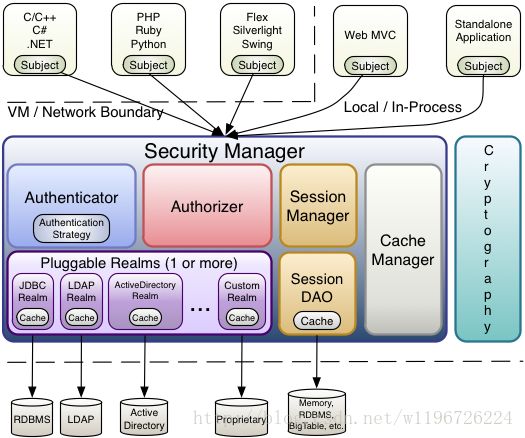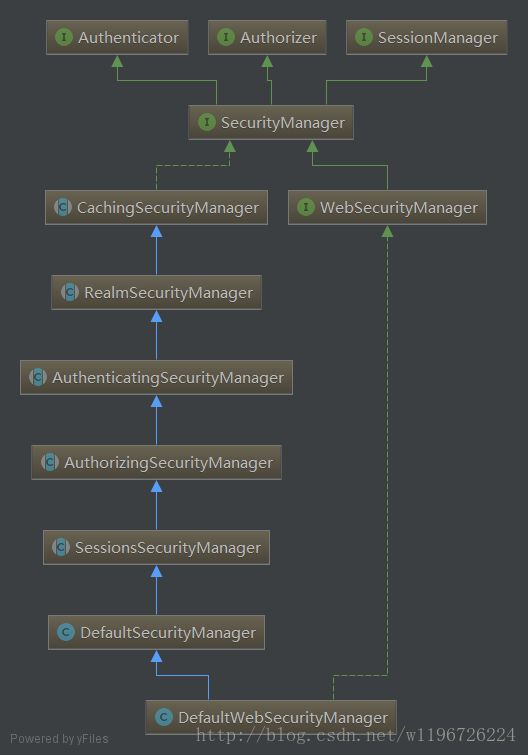文章转载自:http://blog.csdn.net/w1196726224/article/details/53560385
Apache Shiro 是一个强大且灵活的 Java 开源安全框架,拥有登录认证、授权管理、企业级会话管理和加密等功能,相比 spring Security 来说要更加的简单。
本文主要介绍 Shiro 的登录认证(Authentication)功能,主要从 Shiro 设计的角度去看这个登录认证的过程。
一、Shiro 总览
首先,我们思考整个认证过程的业务逻辑:
获取用户输入的用户名,密码;
从服务器数据源中获取相应的用户名和密码;
判断密码是否匹配,决定是否登录成功。
我们现在来看看 Shiro 是如何设计这个过程的:
图中包含三个重要的 Shiro 概念:Subject
、SecurityManager
、Realm
。接下来,分别介绍这三者有何用:
Subject:表示“用户”,表示当前执行的用户。Subject
实例全部都绑定到了一个 SecurityManager
上,当和 Subject
交互时,它是委托给 SecurityManager
去执行的。
SecurityManager:Shiro 结构的心脏,协调它内部的安全组件(如登录,授权,数据源等)。当整个应用配置好了以后,大多数时候都是直接和 Subject
的 API 打交道。
Realm:数据源,也就是抽象意义上的 DAO 层。它负责和安全数据交互(比如存储在数据库的账号、密码,权限等信息),包括获取和验证。Shiro 支持多个 Realm,但是至少也要有一个。Shiro 自带了很多开箱即用的 Reams,比如支持 LDAP、关系数据库(JDBC)、INI 和 properties 文件等。但是很多时候我们都需要实现自己的 Ream 去完成获取数据和判断的功能。
登录验证的过程就是:Subject
执行 login
方法,传入登录的「用户名」和「密码」,然后SecurityManager
将这个 login
操作委托给内部的登录模块,登录模块就调用 Realm
去获取安全的「用户名」和「密码」,然后对比,一致则登录,不一致则登录失败。
Shiro 详细结构:
二、Shiro 登录示例
代码来自 Shiro 官网教程。Shiro 配置 INI 文件:
----------------------------------------------------------------------------# Users and their (optional) assigned roles# username = password, role1, role2, ..., roleN# ----------------------------------------------------------------------------[users]wang=123
1
2
3
4
5
6
1
2
3
4
5
6
测试 main 方法:
public static void main(String[] args) { log.info("My First Apache Shiro Application"); //1.从 Ini 配置文件中获取 SecurityManager 工厂 Factory
1
2
3
4
5
6
7
8
9
10
11
12
13
14
15
16
17
18
19
20
21
22
23
24
25
26
27
28
29
30
31
32
33
34
35
36
37
38
1
2
3
4
5
6
7
8
9
10
11
12
13
14
15
16
17
18
19
20
21
22
23
24
25
26
27
28
29
30
31
32
33
34
35
36
37
38
三、登录逻辑详解
Shiro 登录过程主要涉及到 Subject.login
方法,接下来我们将通过查看源码来分析整个登录过程。
创建 AuthenticationToken
接口的实例 token,比如例子中的 UsernamePasswordToken
,包含了登录的用户名和密码;
获取当前用户 Subject
,然后调用 Subject.login(AuthenticationToken)
方法;
Subject
将 login
代理给 SecurityManager
的 login()
**3.1 创建AuthenticationToken
**
第一步是创建 AuthenticationToken
接口的身份 token,比如例子中的 UsernamePasswordToken
。
package org.apache.shiro.authc;public interface AuthenticationToken extends Serializable { // 获取“用户名” Object getPrincipal(); // 获取“密码” Object getCredentials();}
1
2
3
4
5
6
7
8
1
2
3
4
5
6
7
8
3.2 获取当前用户并执行登录
获取的 Subject
当前用户是我们平时打交道最多的接口,有很多方法,但是这里我们只分析 login
方法。
package org.apache.shiro.subject;public interface Subject { void login(AuthenticationToken token) throws AuthenticationException;}
1
2
3
4
5
6
7
1
2
3
4
5
6
7
login
方法接受一个 AuthenticationToken
参数,如果登录失败则抛出 AuthenticationException
异常,可通过判断异常类型来知悉具体的错误类型。
接下来,分析 Subject
接口的实现类 DelegatingSubject
是如何实现 login
方法的:
public void login(AuthenticationToken token) throws AuthenticationException { clearRunAsIdentitiesInternal(); // 代理给SecurityManager Subject subject = securityManager.login(this, token); ...}
1
2
3
4
5
6
1
2
3
4
5
6
3.3 SecurityManager 接口
前面说过,整个 Shiro 安全框架的心脏就是 SecurityManager,我们看这个接口都有哪些方法:
package org.apache.shiro.mgt;public interface SecurityManager extends Authenticator, Authorizer, SessionManager { Subject login(Subject subject, AuthenticationToken authenticationToken) throws AuthenticationException; void logout(Subject subject); Subject createSubject(SubjectContext context);}
1
2
3
4
5
6
7
8
9
10
1
2
3
4
5
6
7
8
9
10
SecurityManager 包含很多内置的模块来完成功能,比如登录(Authenticator
),权限验证(Authorizer
)等。这里我们看到 SecurityManager 接口继承了 Authenticator
登录认证的接口:
package org.apache.shiro.authc;public interface Authenticator { public AuthenticationInfo authenticate(AuthenticationToken authenticationToken) throws AuthenticationException;}
1
2
3
4
5
6
7
1
2
3
4
5
6
7
那么,SecurityManager
的实现都是怎样来实现 Authenticator
接口的呢?答案是:使用了组合。SecurityManager 都拥有一个 Authenticator
的属性,这样**调用 SecurityManager.authenticate
** 的时候,是委托给内部的 Authenticator
属性去执行的。
3.4 SecurityManager.login 的实现
// DefaultSecurityManager.javapublic Subject login(Subject subject, AuthenticationToken token) throws AuthenticationException { AuthenticationInfo info; try { info = authenticate(token); } catch (AuthenticationException ae) { try { onFailedLogin(token, ae, subject); } catch (Exception e) { if (log.isInfoEnabled()) { log.info("onFailedLogin method threw an " + "exception. Logging and propagating original AuthenticationException.", e); } } throw ae; //propagate } Subject loggedIn = createSubject(token, info, subject); onSuccessfulLogin(token, info, loggedIn); return loggedIn;}// AuthenticatingSecurityManager.java/** * Delegates to the wrapped {@link org.apache.shiro.authc.Authenticator Authenticator} for authentication. */public AuthenticationInfo authenticate(AuthenticationToken token) throws AuthenticationException { return this.authenticator.authenticate(token);}
1
2
3
4
5
6
7
8
9
10
11
12
13
14
15
16
17
18
19
20
21
22
23
24
25
26
27
28
29
30
31
1
2
3
4
5
6
7
8
9
10
11
12
13
14
15
16
17
18
19
20
21
22
23
24
25
26
27
28
29
30
31
调用自己的 authenticate
方法执行登录;
在 authenticate
方法中代理给 Authenticator
接口类型的属性去真正执行 authenticate(token)
方法。
3.5 Authenticator 登录模块
Authenticator
接口如下:
package org.apache.shiro.authc;public interface Authenticator { public AuthenticationInfo authenticate(AuthenticationToken authenticationToken) throws AuthenticationException;}
1
2
3
4
5
6
7
1
2
3
4
5
6
7
其实现类有 AbstractAuthenticator
和 ModularRealmAuthenticator
:
下面来看看如何实现的 authenticate
方法:
// AbstractAuthenticator.javapublic final AuthenticationInfo authenticate(AuthenticationToken token) throws AuthenticationException { AuthenticationInfo info; try { // 调用doAuthenticate方法 info = doAuthenticate(token); if (info == null) { ... } } catch (Throwable t) { ... } ...}// ModularRealmAuthenticator.javaprotected AuthenticationInfo doAuthenticate(AuthenticationToken authenticationToken) throws AuthenticationException { assertRealmsConfigured(); Collection
1
2
3
4
5
6
7
8
9
10
11
12
13
14
15
16
17
18
19
20
21
22
23
24
25
26
27
28
29
30
31
32
33
34
35
36
37
38
1
2
3
4
5
6
7
8
9
10
11
12
13
14
15
16
17
18
19
20
21
22
23
24
25
26
27
28
29
30
31
32
33
34
35
36
37
38
从源码中可以看出,最后会调用 Realm
的 getAuthenticationInfo(AuthenticationToken)
方法。
3.6 Realm 接口
Realm 相当于数据源,功能是通过 AuthenticationToken
获取数据源中的安全数据,这个过程中可以抛出异常,告诉 shiro 登录失败。
package org.apache.shiro.realm;public interface Realm { // 获取 shiro 唯一的 realm 名称 String getName(); // 是否支持给定的 AuthenticationToken 类型 boolean supports(AuthenticationToken token); // 获取 AuthenticationInfo AuthenticationInfo getAuthenticationInfo(AuthenticationToken token) throws AuthenticationException;}
1
2
3
4
5
6
7
8
9
10
11
12
13
1
2
3
4
5
6
7
8
9
10
11
12
13
Shiro 自带了很多开箱即用的 Realm 实现,具体的类图如下:
3.7 总结
到此,我们把整个 Shiro 的登录认证流程分析了一遍。
创建 AuthenticationToken
,然后调用 Subject.login
方法进行登录认证;
Subject
委托给 SecurityManager
;
SecurityManager
委托给 Authenticator
接口;
Authenticator
接口调用 Realm
获取登录信息。
整个过程中,如果登录失败,就抛出异常,是使用异常来进行逻辑控制的。
四、登录密码的存储
页面使用 Https 协议;
页面传送密码时要先加密后再传输,最好是不可逆的加密算法(MD5,SHA2);
后端存储时要结合盐(随机数)一起加密存储;
使用不可逆的加密算法,而且可以加密多次;
把加密后的密码和盐一起存储到数据库;
五、学习 Shiro 源码感悟
从整体去思考框架的实现,带着业务逻辑去看实现逻辑;
不要抠细节,要看抽象,学习其实现方法;
首先看官方文档,官方文档一般会从整体设计方面去说明,遇到具体的接口再去看Javadoc文档;
结合类图等工具方便理解;
六、参考
Apache Shiro
跟我学Shiro目录贴




